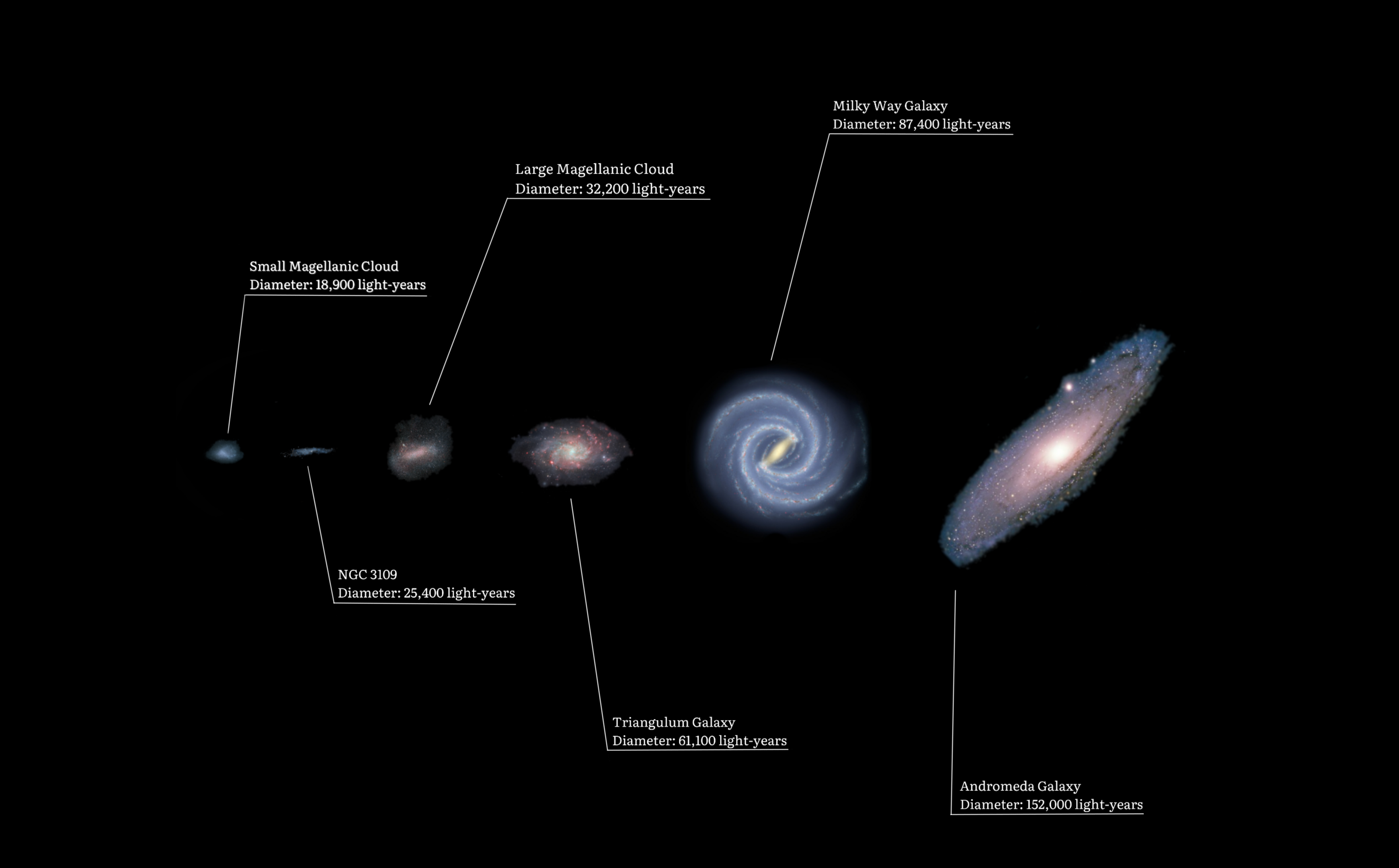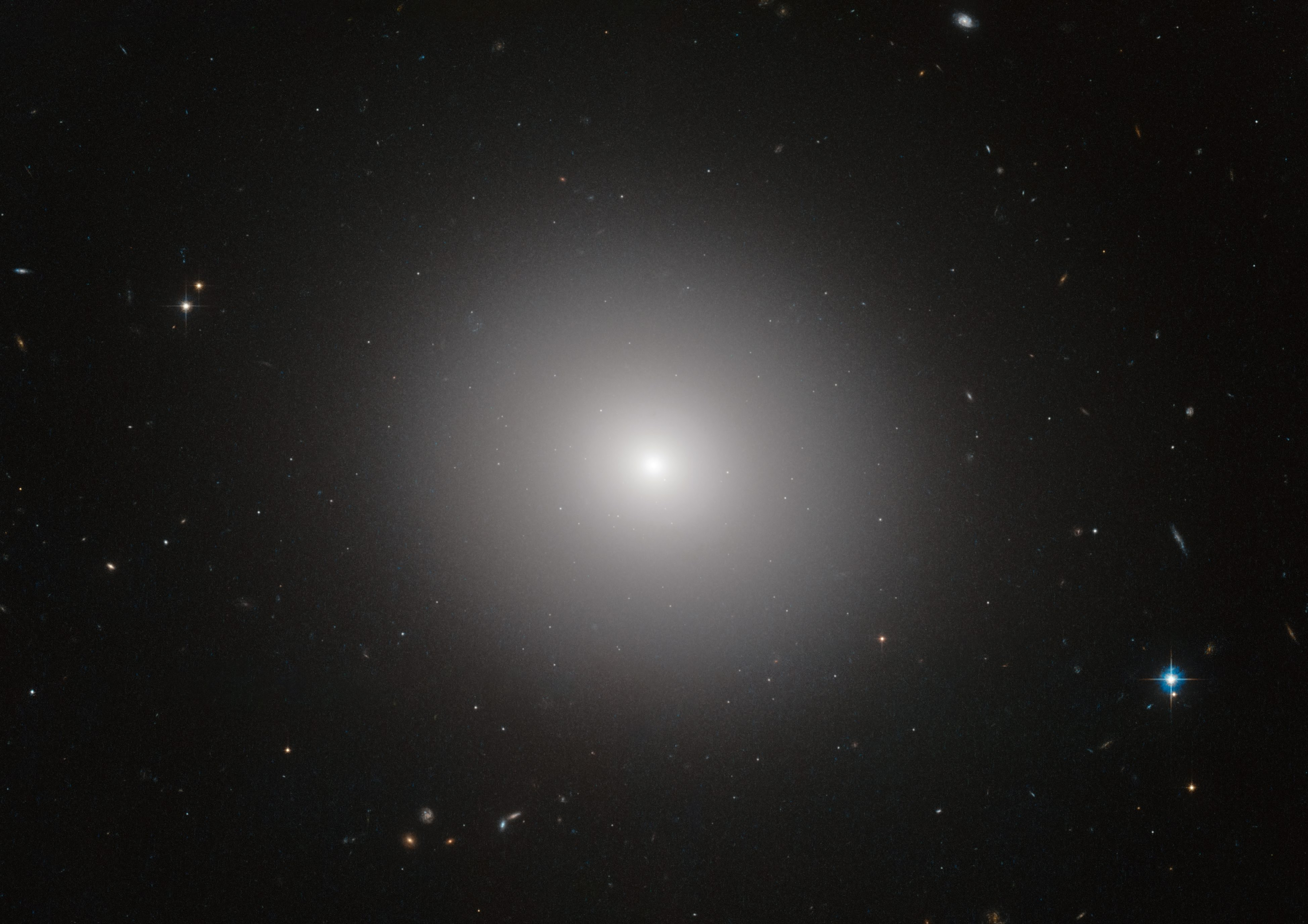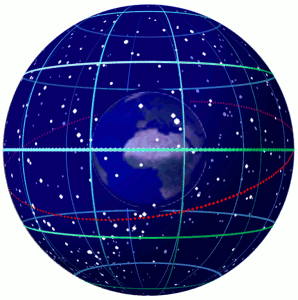|
LEDA 74886
LEDA 74886, also known by its 2MASX designation 2MASX J03404323-1838431, and sometimes known as the Emerald-cut Galaxy, is a dwarf galaxy with a rare rectangular shape. It is located at a distance of about in the Eridanus (constellation), Eridanus constellation. The galaxy was detected in a wide field of view image taken by the Subaru Telescope using the Subaru Prime Focus Camera (Suprime-Cam). Using the Keck Telescope, a thin galactic disc, disc with a side on orientation was confirmed to be lurking at the center of LEDA 74886, and spinning at a speed of 33 km/s at the orbital radius of half a kpc. LEDA 74886 has a mass of around 109 Solar mass, M☉ (Compared to the Milky Way's mass of about 1012 Solar mass, M☉). Location LEDA 74886 is located in the celestial sphere at a right ascension (\alpha) of , and a declination (\delta) of (J2000). It is located within the Galactic corona of NGC 1407, a massive spherical galaxy which is located approximately 163,000 ly (50 kpc) to th ... [...More Info...] [...Related Items...] OR: [Wikipedia] [Google] [Baidu] |
Subaru Telescope
is the telescope of the National Astronomical Observatory of Japan, located at the Mauna Kea Observatory on Hawaii. It is named after the open star cluster known in English as the Pleiades. It had the largest monolithic primary mirror in the world from its commissioning until 2005. Overview The Subaru Telescope is a Ritchey-Chretien reflecting telescope. Instruments can be mounted at a Cassegrain focus below the primary mirror; at either of two Nasmyth focal points in enclosures on the sides of the telescope mount, to which light can be directed with a tertiary mirror; or at the prime focus in lieu of a secondary mirror, an arrangement rare on large telescopes, to provide a wide field of view suited to deep wide-field surveys. In 1984, the University of Tokyo formed an engineering working group to develop and study the concept of a telescope. In 1985, the astronomy committee of Japan's science council gave top priority to the development of a "Japan National Large ... [...More Info...] [...Related Items...] OR: [Wikipedia] [Google] [Baidu] |
Solar Mass
The solar mass () is a standard unit of mass in astronomy, equal to approximately . It is often used to indicate the masses of other stars, as well as stellar clusters, nebulae, galaxies and black holes. It is approximately equal to the mass of the Sun. This equates to about two nonillion ( short scale), two quintillion (long scale) kilograms or 2000 quettagrams: The solar mass is about times the mass of Earth (), or times the mass of Jupiter (). History of measurement The value of the gravitational constant was first derived from measurements that were made by Henry Cavendish in 1798 with a torsion balance. The value he obtained differs by only 1% from the modern value, but was not as precise. The diurnal parallax of the Sun was accurately measured during the transits of Venus in 1761 and 1769, yielding a value of (9 arcseconds, compared to the present value of ). From the value of the diurnal parallax, one can determine the distance to the Sun from the geome ... [...More Info...] [...Related Items...] OR: [Wikipedia] [Google] [Baidu] |
NGC 4488
NGC 4488 is a lenticular galaxy located about 60 million light-years away in the constellation of Virgo. The galaxy was discovered by astronomer William Herschel on December 28, 1785. NGC 4488 is a member of the Virgo Cluster. Structure NGC 4488 has an unusual rectangular-shaped structure similar to the galaxy LEDA 74886. The galaxy does not have an inner disk. It also has two arms coming off diagonally opposite sides suggesting that NGC 4488 has had a gravitational interaction with another galaxy. See also * List of NGC objects (4001–5000) * LEDA 74886 * Peculiar galaxy A peculiar galaxy is a galaxy of unusual size, shape, or composition. Between five and ten percent of known galaxies are categorized as peculiar. Astronomers have identified two types of peculiar galaxies: ''interacting galaxies'' and ''active ga ... References External links {{DEFAULTSORT:NGC 4488 Lenticular galaxies Virgo (constellation) 4488 Virgo Cluster 41363 7653 Astronomical ob ... [...More Info...] [...Related Items...] OR: [Wikipedia] [Google] [Baidu] |
Local Group
The Local Group is the galaxy group that includes the Milky Way. It has a total diameter of roughly , and a total mass of the order of . It consists of two collections of galaxies in a "dumbbell" shape: the Milky Way and its satellites form one lobe, and the Andromeda Galaxy and its satellites constitute the other. The two collections are separated by about and are moving toward one another with a velocity of . The group itself is a part of the larger Virgo Supercluster, which may be a part of the Laniakea Supercluster. The exact number of galaxies in the Local Group is unknown as some are occluded by the Milky Way; however, at least 80 members are known, most of which are dwarf galaxies. The two largest members, the Andromeda Galaxy and the Milky Way, are both spiral galaxies with masses of about solar masses each. Each has its own system of satellite galaxies: * The Andromeda Galaxy's satellite system consists of Messier 32 (M32), Messier 110 (M110), NGC 147, ... [...More Info...] [...Related Items...] OR: [Wikipedia] [Google] [Baidu] |
Sextans A
Sextans A (also known as UGCA 205) is a small dwarf galaxy, dwarf irregular galaxy. It spans about 5000 light-years across, and is located at 4.3 million light-years away, in the outskirts of the Local Group of galaxies, which includes the Milky Way galaxy, and to which Sextans A may or may not belong. Sextans A has a peculiar square shape. Massive short-lived stars exploded in supernovae that caused more star formation, triggering yet more supernovae, ultimately resulting in an expanding shell. Young blue stars now highlight areas and shell edges high in current star formation, which from the perspective of observers on Earth appears roughly square. The 10.4m telescope Gran Telescopio Canarias recently observed the OB-type stars that power the giant HII regions. See also * Sextans B References External links * {{DEFAULTSORT:Sextans A Irregular galaxies Dwarf galaxies Low surface brightness galaxies NGC 3109 subgroup Sextans (constellation) Principal Galaxies Catalog ... [...More Info...] [...Related Items...] OR: [Wikipedia] [Google] [Baidu] |
SDSS J074018 , a school in Delta, British Columbia, Canada
{{disambiguation ...
SDSS may refer to: * Sloan Digital Sky Survey, a major multi-filter imaging and spectroscopic redshift survey * Social Democratic Party of Slovakia * Spatial Decision Support System, a GIS based decision aiding system * Independent Democratic Serb Party, a political party of Croatian Serbs (''Samostalna demokratska srpska stranka'' in Serbo-Croatian) * South Delta Secondary School South Delta Secondary (SDSS) is a public high school in Tsawwassen, British Columbia, Canada. There are approximately 1,500 students enrolled in each grade 8 through 12 (as of 2019/2020). Graduation rates in the years 2005 to 2010 vary between 9 ... [...More Info...] [...Related Items...] OR: [Wikipedia] [Google] [Baidu] |
Spherical Galaxy
An elliptical galaxy is a type of galaxy with an approximately ellipsoidal shape and a smooth, nearly featureless image. They are one of the four main classes of galaxy described by Edwin Hubble in his Hubble sequence and 1936 work ''The Realm of the Nebulae'', with their intermediate scale disks, a subset of the "early-type" galaxy population. Most elliptical galaxies are composed of older, low-mass stars, with a sparse interstellar medium and minimal star formation activity, and they tend to be surrounded by large numbers of globular clusters. Elliptical galaxies are believed to make up approximately 10–15% of galaxies in the Virgo Supercluster, and they are not the dominant type of galaxy in the universe overall. They are preferentially found close to the centers of galaxy clusters. Elliptical galaxies range in size from dwarf ellipticals with tens of millions of stars, to supergiants of over one hundred trillion stars that dominate their galaxy clusters. Originally, Edw ... [...More Info...] [...Related Items...] OR: [Wikipedia] [Google] [Baidu] |
Galactic Corona
The terms galactic corona and gaseous corona have been used in the first decade of the 21st century to describe a hot, ionised, gaseous component in the galactic halo of the Milky Way. A similar body of very hot and tenuous gas in the halo of any spiral galaxy may also be described by these terms. Current hypothetical scenario The hypothetical source of the galactic halo of ''coronal gas'' may be the cumulative output of many “galactic fountains” in the galactic disc ejecting hot gas. The hypothesis is that a single supernova and then its supernova remnant both produce hot ionized gas that supplies an individual “galactic fountain”. The expelled material forms a giant bubble of high-pressure, low density, hot gas in the denser, cooler gas and dust of the galactic disc. At least some of those bubbles extend high or low enough, vertically, to pierce through the denser disk, and form “chimneys” which exhaust the hot gas into the halo, analogous to a terrestrial g ... [...More Info...] [...Related Items...] OR: [Wikipedia] [Google] [Baidu] |
Declination
In astronomy, declination (abbreviated dec; symbol ''δ'') is one of the two angles that locate a point on the celestial sphere in the equatorial coordinate system, the other being hour angle. Declination's angle is measured north or south of the celestial equator, along the hour circle passing through the point in question. The root of the word ''declination'' (Latin, ''declinatio'') means "a bending away" or "a bending down". It comes from the same root as the words ''incline'' ("bend foward") and ''recline'' ("bend backward"). In some 18th and 19th century astronomical texts, declination is given as ''North Pole Distance'' (N.P.D.), which is equivalent to 90 – (declination). For instance an object marked as declination −5 would have an N.P.D. of 95, and a declination of −90 (the south celestial pole) would have an N.P.D. of 180. Explanation Declination in astronomy is comparable to geographic latitude, projected onto the celestial sphere, and right ascension is ... [...More Info...] [...Related Items...] OR: [Wikipedia] [Google] [Baidu] |
Right Ascension
Right ascension (abbreviated RA; symbol ) is the angular distance of a particular point measured eastward along the celestial equator from the Sun at the March equinox to the ( hour circle of the) point in question above the earth. When paired with declination, these astronomical coordinates specify the location of a point on the celestial sphere in the equatorial coordinate system. An old term, ''right ascension'' ( la, ascensio recta), "''Ascensio recta'' Solis, stellæ, aut alterius cujusdam signi, est gradus æquatorus cum quo simul exoritur in sphæra recta"; roughly translated, "''Right ascension'' of the Sun, stars, or any other sign, is the degree of the equator that rises together in a right sphere" refers to the ''ascension'', or the point on the celestial equator that rises with any celestial object as seen from Earth's equator, where the celestial equator intersects the horizon at a right angle. It contrasts with ''oblique ascension'', the point on the ce ... [...More Info...] [...Related Items...] OR: [Wikipedia] [Google] [Baidu] |
Celestial Sphere
In astronomy and navigation, the celestial sphere is an abstract sphere that has an arbitrarily large radius and is concentric to Earth. All objects in the sky can be conceived as being projected upon the inner surface of the celestial sphere, which may be centered on Earth or the observer. If centered on the observer, half of the sphere would resemble a hemispherical screen over the observing location. The celestial sphere is a conceptual tool used in spherical astronomy to specify the position of an object in the sky without consideration of its linear distance from the observer. The celestial equator divides the celestial sphere into northern and southern hemispheres. Introduction Because astronomical objects are at such remote distances, casual observation of the sky offers no information on their actual distances. All celestial objects seem equally far away, as if fixed onto the inside of a sphere with a large but unknown radius, which appears to rotate west ... [...More Info...] [...Related Items...] OR: [Wikipedia] [Google] [Baidu] |
Milky Way
The Milky Way is the galaxy that includes our Solar System, with the name describing the galaxy's appearance from Earth: a hazy band of light seen in the night sky formed from stars that cannot be individually distinguished by the naked eye. The term ''Milky Way'' is a translation of the Latin ', from the Greek ('), meaning "milky circle". From Earth, the Milky Way appears as a band because its disk-shaped structure is viewed from within. Galileo Galilei first resolved the band of light into individual stars with his telescope in 1610. Until the early 1920s, most astronomers thought that the Milky Way contained all the stars in the Universe. Following the 1920 Great Debate between the astronomers Harlow Shapley and Heber Curtis, observations by Edwin Hubble showed that the Milky Way is just one of many galaxies. The Milky Way is a barred spiral galaxy with an estimated D25 isophotal diameter of , but only about 1,000 light years thick at the spiral arms (more at the ... [...More Info...] [...Related Items...] OR: [Wikipedia] [Google] [Baidu] |





